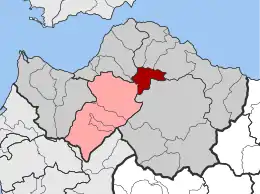Leontio
Λεόντιο | |
|---|---|
 | |
 Leontio Location within the regional unit  | |
| Coordinates: 38°7′N 21°55′E / 38.117°N 21.917°E | |
| Country | Greece |
| Administrative region | West Greece |
| Regional unit | Achaea |
| Municipality | Erymanthos |
| Districts | 3 |
| • Municipal unit | 71.59 km2 (27.64 sq mi) |
| Highest elevation | 1,400 m (4,600 ft) |
| Lowest elevation | 772 m (2,533 ft) |
| Population (2011)[1] | |
| • Rural | 246 |
| • Municipal unit | 335 |
| • Municipal unit density | 4.7/km2 (12/sq mi) |
| Community | |
| • Population | 284 (2011) |
| Time zone | UTC+2 (EET) |
| • Summer (DST) | UTC+3 (EEST) |
| Postal code | 250 08 |
| Vehicle registration | AX |
| Website | leontio.gr |
Leontio (Greek: Λεόντιο, romanized: Leóntio, before 1923: Γουρζούμισα, Gourzoúmisa[2]) is a mountain village and a former municipality in the municipality of Erymanthos, Achaea, West Greece, Greece. Since the 2011 local government reform it is part of the municipality Erymanthos, of which it is a municipal unit.[3] The municipal unit has an area of 71.586 km2.[4] It is situated in the southern foothills of the Panachaiko, 13 km east of Chalandritsa, 22 km southeast of Patras, 20 km southwest of Aigio and 19 km northwest of Kalavryta. Its population in 2011 was 246 for the village, 284 for the community and 380 for the municipal unit. The village was renamed for the ancient town of Leontium, the remains of which lie nearby.
Subdivisions

The municipal unit Leontio is subdivided into the following communities (constituent villages in brackets):
- Ano Mazaraki
- Demesticha
- Leontio (Leontio, Vetaiika, Golemi, Thomaiika, Katsaitaiika, Kounavaiika, Ovryokambos)
Population
| Year | Population (village) |
|---|---|
| 1981 | 518 |
| 1991 | 333 |
| 2001 | 373 |
| 2011 | 246 |
History
Evidence suggests that the Achaeans settled Leontio after the Trojan Wars, at this time it was a Polis. This is supported by archeological excavations in the area by the archaeologist N. Kiparisis during the period 1931–32. Mycenean tombs from the 14th-12th century BC were found. The different artifacts excavated in a number of ancient cemeteries confirmed the Polis flourished at about 1,000 BC. Though older findings date it back to 3,000-2,000 BC. The acropolis dates back to around the 3rd century BC.
It was located on the ancient border of Achaea and Arcadia near Vlasia[5] where excavations uncovered a Mycenean tomb and an ancient theater from the 4th century BC.[6] The temple of Artemis was located along the ancient road which led to Arcadia. Its length was 35 m and its width was 11 m.[7]
The city was destroyed at the end of the 3rd century BC by Philip V Macedon.[8] Leontio controlled several places including Chios and Leontopoda.[9] The area followed the fate of the rest of Achaea.
References
- 1 2 "Απογραφή Πληθυσμού - Κατοικιών 2011. ΜΟΝΙΜΟΣ Πληθυσμός" (in Greek). Hellenic Statistical Authority.
- ↑ Name changes of settlements in Greece
- ↑ "ΦΕΚ B 1292/2010, Kallikratis reform municipalities" (in Greek). Government Gazette.
- ↑ "Population & housing census 2001 (incl. area and average elevation)" (PDF) (in Greek). National Statistical Service of Greece. Archived from the original (PDF) on 2015-09-21.
- ↑ www.styga.gr
- ↑ www.diodos.gr Archived July 21, 2011, at the Wayback Machine
- ↑ nea.gr Archived February 27, 2008, at the Wayback Machine
- ↑ kalavrita.gr Archived August 6, 2007, at the Wayback Machine
- ↑ Stefanos Thomopoulos, History Of The Cities In Patras From The Ancient Period Until 1821, Volume I, Achaikes Editions, Patras 1998 ISBN 960-7960-08-4